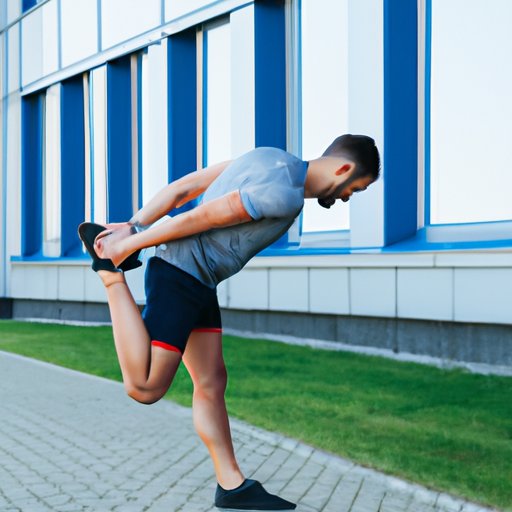
The Ultimate Guide to Stretching: Tips, Tricks, and Stretches for a Healthier You
Stretching is an essential part of improving our overall health and well-being. However, many people overlook the importance of stretching and the benefits it offers. Stretching can improve flexibility, reduce stiffness and tension, prevent injuries, enhance endurance, and aid in muscle recovery. In this article, we will explore the different types of stretches, their benefits, and how to incorporate them into our daily routine. Let’s dive in and learn how to stretch effectively.
5 Simple Stretches to Start Your Day Right
Starting your day with stretching can help you feel refreshed and energized. Here are five simple and easy stretches that are perfect for beginners:
- Neck stretch – Sit on the edge of your bed, lift your right arm and place it over your head, and gently pull your head to the right side. Hold for 10-15 seconds. Repeat on the other side.
- Shoulder stretch – Stand with your feet shoulder-width apart, lift your left arm, and place it across your chest. Use your right arm to pull it closer to your body and hold for 15-20 seconds. Repeat with the other arm.
- Hamstring stretch – Sit on the floor with your legs extended in front of you. Reach for your toes, keeping your back straight, and hold for 10-15 seconds.
- Cat-cow stretch – Begin on all fours, inhale and arch your back, looking up towards the ceiling. Exhale and round your spine, bringing your chin towards your chest. Repeat for 10-15 breaths.
- Butterfly stretch – Sit on the floor with the soles of your feet touching, and gently push your knees towards the ground. Hold for 10-15 seconds.
Why Stretching is Important for Your Health, and How to Do it Properly
Stretching offers many benefits beyond just feeling good. Incorporating stretching into your daily routine can improve your posture, reduce stress and tension, and even reduce your risk of injury. However, stretching improperly can lead to injuries. Here are some tips for doing it properly:
- Warm-up before stretching – Stretching cold muscles can do more harm than good. Before stretching, do some light exercises to warm up your muscles.
- Don’t push yourself too hard – While stretching should feel good, it should never cause pain. If you feel any discomfort, back off or stop altogether.
- Breathe deeply – It’s essential to breathe deeply and evenly while stretching. Inhale as you prepare to stretch and exhale as you relax into the stretch.
- Hold the stretch – You should hold each stretch for 10-30 seconds, depending on your level of comfort.
- Don’t forget to cool down – After stretching, take a few minutes to cool down and relax.
By following these tips, you can improve your stretching routine and enjoy maximum benefits.
Quick and Easy Office Stretches to Combat Sitting-Induced Stiffness
Sitting in front of a computer for long hours can lead to stiffness and tension in the neck, shoulders, and back. These easy office stretches can help you to combat the negative effects of a desk-bound job:
- Shoulder shrugs – While sitting or standing, lift your shoulders towards your ears, hold for a few seconds, and release.
- Wrist stretches – Hold out your arm and gently press your palm towards the ground with your other hand. Hold for a few seconds, and then repeat on the other arm.
- Neck stretches – Tilt your head to one side, bringing your ear to your shoulder, hold for a few seconds, and then repeat on the other side.
- Leg swings – Stand up and swing one leg back and forth, then switch to the other leg.
- Eye exercises – Look away from your computer screen every 20 minutes, and focus on something far away for 20-30 seconds.
Stretching for Runners: Make Sure You’re Doing it Right
Stretching can be especially beneficial for runners, but it’s essential to do it properly. Here are some tips for incorporating stretching into your running routine:
- Stretch before and after your run – Stretching before running can help warm up your muscles and prevent injuries, while stretching after can aid in muscle recovery.
- Focus on dynamic stretches – Dynamic stretching, like leg swings and knee lifts, is better for runners than static stretches.
- Don’t overdo it – While stretching is important, it should never replace a proper warm-up or workout routine.
- Incorporate variety – Don’t stick to the same stretches every time you run. Try out different stretches to improve your flexibility and prevent boredom.
- Listen to your body – If you feel any pain or discomfort while stretching, stop immediately.
Stretching: The Secret to Achieving Your Fitness Goals
Stretching can help you achieve your fitness goals more quickly and efficiently. Here’s how:
- Increases range of motion – Stretching can help improve your flexibility and range of motion in your joints, allowing you to perform exercises more effectively.
- Prevents injuries – Stretching helps to loosen and warm up your muscles, preventing injury.
- Speeds up recovery – Stretching increases blood flow to your muscles, helping to bring nutrients and oxygen to repair damaged tissues.
- Improves posture – Stretching can help improve your posture by reducing tension in your muscles, promoting proper alignment, and reducing the risk of back pain.
- Reduces stress – Stretching promotes relaxation and reduces stress levels, which can help to improve your overall sense of well-being.
Conclusion:
Stretching is a fundamental part of improving our overall health and well-being. Whether you are a fitness enthusiast or someone who spends most of their hours sitting, incorporating stretching into your routine can have numerous benefits. By following the tips and trying out different stretches outlined above, you can improve your flexibility, prevent injury, reduce stress and tension, and enhance your overall quality of life.




